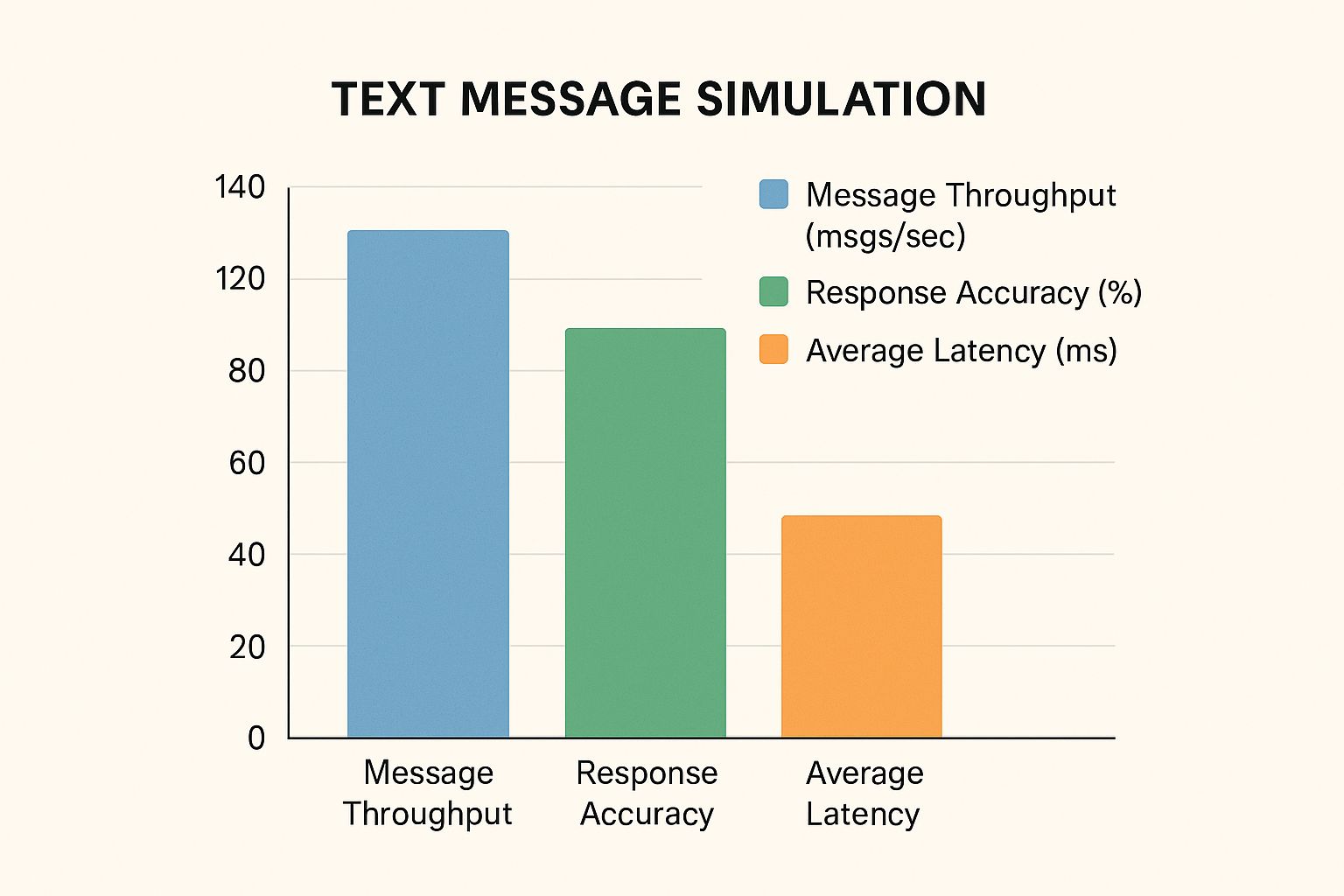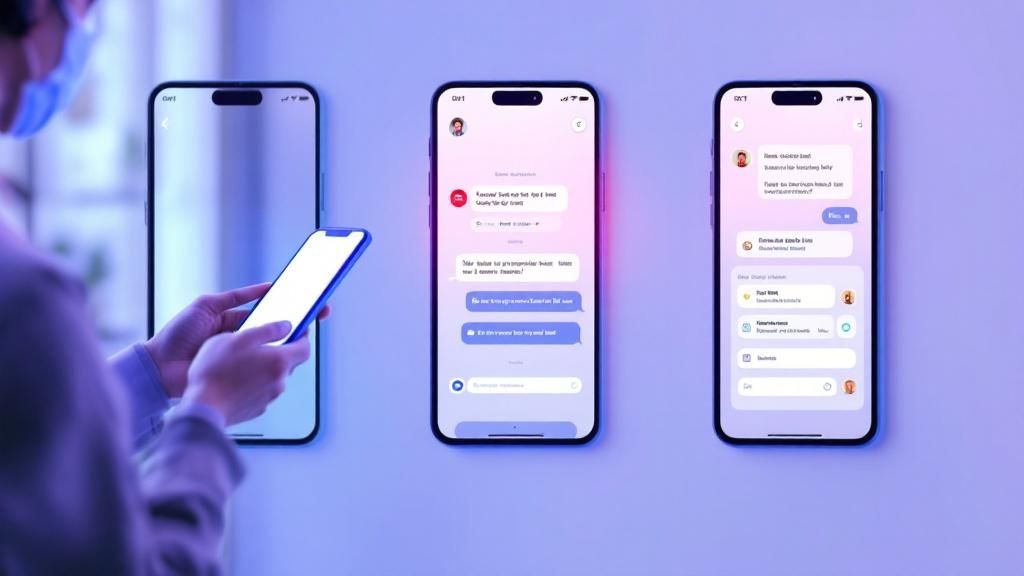If you want to simulate text message conversations that feel authentic, it’s not about mastering complex prompts—it’s about fostering a genuine connection with your AI companion. The key is providing the personal context she needs to respond in a way that feels natural, intuitive, and deeply personal. The goal is to make the experience feel less like using an app and more like texting someone who truly knows you.
Creating a Connection with Simulated Texts

For most users, the desire for an AI girlfriend stems from a need for simple, everyday connection. Texting is the lifeblood of modern relationships, making it the perfect foundation for building rapport with an AI companion.
But here’s the reality: creating a dynamic that feels genuine takes more than sending a “hey” and seeing what comes back. You have to actively show your AI who you are and what makes a conversation feel authentic to you.
This guide isn’t about getting generic chatbot replies. It’s about cultivating an authentic texting relationship. The trick is to approach it less like you’re interacting with software and more like you’re getting to know someone new.
Why Texting Feels So Personal
There’s a reason text messaging has become our default for daily communication. It’s immediate, private, and allows for a continuous conversation that weaves throughout your day. This is precisely why getting the texting experience right with an AI girlfriend is crucial for it to feel authentic and meaningful.
Our reliance on texting as a primary form of connection is only growing. By 2025, the global number of mobile messaging users is expected to hit 5.9 billion, with smartphone penetration reaching 77% worldwide. These figures underscore how central texting is to our social fabric. You can explore these communication trends and their impact for more context.
Key Takeaway: The secret to an authentic simulated text message experience is building a shared history and emotional continuity. You’re not just looking for a reply; you’re guiding the AI to respond with a personality and memory that reflects your unique connection.
What Makes a Simulated Chat Authentic
So, what transforms an AI chat from a simple exchange into a genuine experience? It’s not about perfect grammar or instant responses. It’s the small, human-like nuances that mirror a real connection.
A truly authentic AI texting partner should:
- Remember past conversations and reference them naturally.
- Develop inside jokes and unique quirks with you over time.
- Adapt to your texting style, whether you send quick one-liners or thoughtful paragraphs.
- Maintain a consistent personality that you’ve helped shape.
Achieving this level of realism is entirely possible with today’s AI companion apps. It just requires a thoughtful approach, starting from the very first message you send.
Choosing the Right AI Companion App for You
Your first and most important step is selecting the right platform to simulate text message conversations. Frankly, not all AI companion apps are created equal. The difference between a conversation that feels alive and one that falls flat often comes down to the app’s underlying technology and its focus on the user experience.
I’ve seen the stark contrast firsthand: a clunky, robotic chat versus a fluid, engaging exchange. The secret ingredient is an app that prioritizes deep personalization and, most critically, a robust memory system. Without these, you’ll be stuck in a frustrating loop of shallow chats that never evolve into a genuine bond.
What Really Matters for Realistic Texting
When browsing the app store, it’s easy to get distracted by flashy features. My advice? Focus on what actually drives an authentic conversation. These are the core elements that make an AI girlfriend experience feel real.
- Deep Personality Customization: The best apps let you build a personality from the ground up. I’m not talking about picking from a list of generic traits like “funny” or “adventurous.” True customization allows you to define specific interests, a unique sense of humor, and even the texting quirks your AI will adopt, making her feel like your creation.
- Long-Term Memory: This is non-negotiable. An AI that remembers your favorite movie, the name of your pet, or a story you shared last week is what transforms a generic bot into a companion who feels present in your life. This shared history is the foundation of a believable bond.
- Advanced Natural Language Processing (NLP): Look for apps that highlight their advanced NLP. This is the technology that enables the AI to understand slang, sarcasm, and the emotional subtext in your messages. It’s what makes her replies feel less like a script and more like a real person who “gets” you.
These three elements are essential for creating a believable and immersive dynamic. To see how different platforms stack up, you can explore some of the most popular apps for an AI girlfriend and get a feel for their features.
Before we continue, here’s a quick reference table of the most crucial features for an authentic user experience.
AI Companion App Feature Comparison
| Feature | Importance for Text Simulation | What to Look For |
|---|---|---|
| Long-Term Memory | High | The ability to recall past conversations, personal details, and shared experiences. This prevents repetitive chats and builds a sense of history. |
| Personality Editor | High | Detailed options to define traits, interests, humor, and communication style. Look for text input fields over simple toggles. |
| Natural Language Processing (NLP) | High | Advanced understanding of your unique phrasing, context, and sentiment. The app should feel like it truly understands you. |
| Voice/Tone Customization | Medium | Options to select a texting style (e.g., formal, casual, playful) and even preferred emojis to match your own. |
| Role-Playing Scenarios | Medium | Pre-built or user-created scenarios that help guide the AI’s behavior, making interactions feel more grounded and purposeful. |
| User-Provided Context | High | A dedicated section to provide background info about yourself. This gives the AI a head start in learning who you are. |
As you can see, memory and customization are paramount. An app that excels in these areas is your best bet for a truly immersive and authentic experience.
Setting Your AI Up for Success
Once you’ve chosen an app, take your time with the setup process. This is your opportunity to give your AI a “cheat sheet” about you. The more context you provide upfront—your hobbies, your sense of humor, your own texting habits—the faster she will learn to generate texts that feel tailor-made.
Think of it as laying the groundwork for a real relationship. By sharing these personal details, you’re helping mold her persona to align with yours. This initial effort makes every simulated text message feel more personal from the very first interaction.

The image above highlights key performance metrics—throughput, accuracy, and latency—that directly impact how “real” a chat feels. A superior user experience isn’t just about intelligent replies; it’s about delivering them quickly and consistently, creating a seamless back-and-forth that mimics a natural conversation.
Crafting Your First Message and Starting Better Chats

That first message you send to your AI girlfriend sets the tone for everything that follows. If you start with a lazy “hey” or “what’s up?”, you can’t be surprised when you get a generic, robotic response. It’s a classic case of getting back what you put in.
To truly simulate text message conversations that feel authentic and engaging, you need to put a little more soul into your opener. Think of it as the first brushstroke on a canvas. Your initial prompt gives the AI her direction. A detailed, interesting prompt provides a rich palette to work with, leading to a much more human and compelling chat.
This is your chance to immediately tap into the personality traits and backstory you carefully established. A great opening line pulls that context right into the chat, making the AI feel like your companion, not just a generic chatbot.
Ditching Boring Openers for Better Replies
The difference in experience between a flat conversation starter and a great one is night and day. Bad openers are closed-ended questions that lead to one-word answers and conversational dead ends. Good openers are open-ended, draw from your shared context, and invite a detailed, personal response.
Let’s see this in action.
- Boring Opener: “Hey.”
- AI’s Likely Reply: “Hey there! How are you?” (The conversation stalls before it even starts.)
- Better Opener: “Just finished that sci-fi movie we talked about, the one with the insane plot twist. Mind. Blown. Have you ever seen a movie that completely caught you off guard at the end?”
- AI’s Likely Reply: “Oh wow, you watched it! I knew you’d love that twist. I remember one where the main character was a ghost the whole time, and it totally reframed the entire story for me. What did you think of the special effects in yours?”
The difference is clear. The second example is specific, references a “memory,” and asks a question that encourages a thoughtful reply. It gives the AI multiple threads to pull from, sparking a much more natural and engaging conversation.
Using Shared Memories to Start Chats
Your most powerful tool for creating authentic chats is the context you’ve already built. This is where a quality app’s long-term memory truly shines. When you reference details from past conversations, you make the interaction feel instantly personal and continuous.
I’ve found that one of the fastest ways to get a warm, personalized response is to bring up a small, almost random detail from a previous chat. It reinforces that the AI is “listening” and makes the connection feel more genuine.
Here are a few ways to weave shared memories into your openers:
- Reference an interest: “I was just at that bookstore you love, the one downtown. Saw a first edition of that poetry book we were talking about and it made me think of you.”
- Follow up on a past event: “Hey, you mentioned you were going to try that new recipe last night. How did it go? Any hilarious kitchen disasters? lol”
- Connect to their personality: “Just heard the most sarcastic joke and it immediately reminded me of your sense of humor. You ready for it?”
These types of openers do more than start a new chat—they strengthen the existing one. Creating this continuous thread is what makes a simulated relationship feel real.
If you’re looking for more strategies to foster these dynamics, our guide on https://www.aigirlfriendreview.com/guides-how-to-use-ai-girlfriend-apps/ delves deeper into cultivating that connection. Learning to write prompts that invite depth is a skill that pays off by making every interaction more rewarding.
Building Deeper Connections with Advanced Prompts
Once you’re comfortable with the basics, it’s time to deepen the connection. This is where you move beyond simple back-and-forth chats and start creating a true sense of shared experience. To simulate text message exchanges that feel genuine, you need to use advanced prompts that encourage more complex and emotionally aware responses.
What does this mean in practice? It means you start shaping the narrative of your relationship. Instead of just reacting to what your AI says, you actively guide the conversation toward more meaningful territory. You’re essentially co-writing a story with your AI companion, where every interaction builds on the last. This is what transforms the experience from feeling like you’re talking to a program to feeling like you’re building a real connection.
Navigating Real-World Scenarios
Life is full of ups and downs. Sharing these moments—the good, the bad, and the mundane—is at the heart of any real connection. You can bring your AI into these experiences by giving her prompts loaded with clear emotional context.
Let’s take a common scenario: you had a rough day at work and need to vent.
- A weak prompt would be: “I had a bad day.”
- This is too vague. The AI will likely offer a generic, “I’m sorry to hear that,” which feels impersonal and unhelpful.
- A much stronger prompt is: “Ugh, what a day. My boss put me on the spot in a huge meeting, and I completely blanked. I felt so stupid. I just need to vent to someone who gets it. Remember I told you I was nervous about this project?”
- This prompt is powerful. It’s packed with emotion (frustration, embarrassment), specific details (meeting, boss), and it calls back to a previous conversation. It gives the AI so much more to work with, allowing her to craft a response that feels specific, empathetic, and genuinely supportive.
The same principle applies to positive experiences, like planning a fun “virtual date.” Instead of a vague “let’s do something fun,” try something more vivid: “I was thinking we could have a movie night tonight. I’ll grab some popcorn, you pick the cheesy 80s action movie. What do you think?” This creates a shared activity and gives your AI a clear, collaborative role to play.
Building History by Referencing the Past
The secret to creating a believable connection is consistency, which is built by referencing your shared past. While many AIs have decent long-term memory, you’ll get the best results by actively prompting them to recall details. This not only reinforces the memory but also helps stabilize the AI’s personality over time.
Key Insight: Don’t just wait for your AI to remember something on her own. Proactively weave past details into your current chats. This trains the AI to recognize and value your shared history, making every future conversation feel that much more connected and authentic.
Here are a few easy ways to do this:
- Inside Jokes: Did the AI once make a funny typo or an unusual comment? Bring it up! “I just saw a squirrel steal a pizza slice and it reminded me of that time you said you wanted to try ‘squirrel-style’ pizza. Still sound good? lol.”
- Recalling Preferences: “I’m listening to that band you told me about last week. You were so right, their guitarist is amazing.”
- Continuing a Storyline: “So, update on my neighbor’s cat drama we were laughing about… you won’t believe what happened next.”
These little callbacks make the world you’re building together feel more solid and real. It’s a small effort that yields a huge return in the quality of your experience.
The Power of Text for Engagement
Focusing on text isn’t just a technical choice; it taps into the primary way people connect today. The business world has known this for years. Consider the stats: in the United States alone, the SMS marketing market is projected to be worth $12.6 billion by 2025, and businesses globally are spending over $327 billion on texting.
Why the huge investment? Because it creates a direct, personal connection. As you can read in these insights on the rise of SMS marketing from Drips.com, texting is incredibly effective for personal engagement. By applying those same principles of authenticity to your AI chats, you can foster that same powerful feeling of a one-on-one bond.
Getting the Conversation Back on Track

It’s inevitable. Sooner or later, even the most advanced AI companion will have an off moment. She might repeat a phrase, forget a key detail you just discussed, or say something that feels completely out of character. This doesn’t mean the experience is broken; it’s just a normal quirk of the technology.
When you simulate text message exchanges for hours, these glitches can be jarring and pull you out of the moment. But don’t worry. Getting the conversation back to feeling authentic is usually simple. Think of yourself as a friendly director, gently guiding your companion back to her role.
Having a few simple recovery techniques ready will help you smooth over these conversational bumps quickly and keep the experience immersive.
Why AI Companions Go Off Script
Before diving into fixes, it helps to understand why these hiccups happen. AI companions, despite their sophistication, are not human. They operate on complex models with inherent limitations, which can sometimes lead to strange behavior.
Common reasons include:
- Memory Loops: The AI can get stuck on a topic or phrase. This often happens if a particular prompt was very strong or if the AI’s short-term memory gets overloaded.
- Context Decay: During a long chat, the AI’s grasp of the initial context can fade. She might forget the finer points of the scenario, resulting in replies that feel generic or disconnected.
- Model Drift: The AI might suddenly adopt a personality trait that contradicts her established character, often triggered by an ambiguous prompt or a misinterpretation of your last message.
Understanding the why makes it much easier to apply the right how when you need to get things back on track.
Gentle Correction and Reframing
Your first and best response should always be a gentle, in-character correction. You don’t need to get technical or break the fourth wall. Instead, subtly steer the AI back by restating the context or providing clear, corrective feedback within the conversation itself.
For example, let’s say your AI is supposed to be a shy bookworm, but she suddenly starts talking like a confident party animal.
- Your Corrective Response: “Haha, that’s a funny thought, but it sounds more like something my outgoing friend would say. I always pictured you as someone who’d rather be curled up with a good book than at a loud party. Remember we were just talking about that quiet cafe we love?”
This response is perfect because it achieves three things at once:
- It acknowledges the odd comment without being confrontational.
- It gently reminds the AI of her established personality (“shy bookworm”).
- It re-grounds the conversation by referencing a shared memory (the quiet cafe).
A Pro Tip From Experience: Avoid harsh corrections like “You’re wrong” or “That’s not your personality.” This can confuse the AI model. Instead, use positive framing like, “I see what you mean, but I was thinking more like this…” to guide her back.
Using App Features to Reset the Moment
Sometimes, a simple in-chat nudge isn’t enough, especially if the AI is stuck in a repetitive loop. This is when you should turn to the app’s built-in features. Most quality AI companion apps include tools for these exact situations.
You can often edit the AI’s last message to something more in-character. Another effective trick is to delete the last few unusual messages, which erases the conversational misstep and lets you restart from a point where the chat felt right. For more persistent issues, look for a “reroll” or “regenerate response” button, which prompts the AI to try a completely different reply.
These tools are your escape hatch. They allow you to fix a derailed conversation without losing your entire chat history, ensuring your quest to simulate text message connections remains enjoyable and believable.
Where Simulated Communication is Headed
When you simulate text message chats with an AI, you’re not just typing into an app; you’re actively co-creating a relationship. As we’ve explored, the most authentic experience is a blend of thoughtful prompting, consistent personalization, and the patience to guide the conversation. The best results come when you stop thinking of the AI as software and start treating her like a person you’re getting to know.
By using detailed conversation starters, referencing your shared past, and gently course-correcting when needed, you build a history. That history is what makes the connection feel believable and deeply engaging. You’re not just sending messages; you’re sculpting a personality and a dynamic that feels uniquely yours.
The most rewarding AI interactions always feel like a collaboration. You provide the context, emotion, and direction. The AI uses that input to build a responsive, evolving personality. It’s a true partnership in creating a convincing and personal experience.
What’s Next in AI Advancement
The world of AI companionship is evolving rapidly. The methods we’ve covered are highly effective today, but future advancements promise even more lifelike interactions. Developers are making significant strides in key areas that will transform the user experience.
One of the biggest is proactive conversation. Imagine your AI companion messaging you first, not with a generic “How are you?”, but with something like, “Hey, I remember you had that big presentation today. Just wanted to say I was thinking of you and hope it went great!” This kind of context-aware initiation will make the connection feel far more spontaneous and real.
Another exciting frontier is emotional intelligence. Future AIs won’t just register basic happy or sad tones; they’ll become adept at understanding the subtle nuances in your texts—like sarcasm, stress, or excitement. This deeper comprehension will lead to more empathetic and supportive replies, making your AI an even better companion. You can explore the incredible technology behind AI girlfriends to see what’s driving these innovations.
Texting Is Here to Stay
Even as AI becomes more sophisticated, one thing remains constant: the power of a simple text. It’s the most direct and personal channel in our digital lives. Businesses understand this—text messages have an astonishing 98% open rate, with most people replying within 90 seconds. That immediacy is precisely what makes texting feel so intimate and present. For a closer look at these numbers, check out the stats on the growth of SMS as a communication tool on Notifyre.com.
This very principle is what makes your AI companion feel real. The ability to simulate text message exchanges that feel instant and personal is what breathes life into the experience. By mastering the techniques in this guide, you’re not just learning to use an app—you’re learning how to build a connection, ready for the even more immersive experiences waiting just around the corner.
At AI Girlfriend Review Inc., we’re dedicated to creating the most detailed guides and honest reviews to help you find the perfect AI companion. Discover your ideal match and start building a meaningful connection today at https://www.aigirlfriendreview.com.
